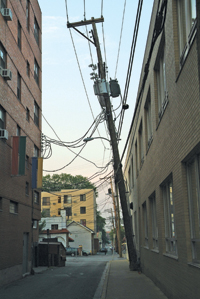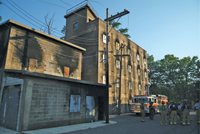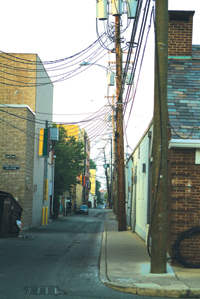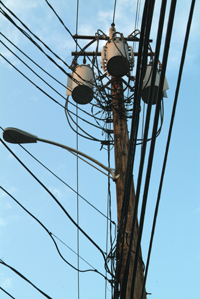
Features
Structural
Training
Back to Basics: November 2009
All fire-service operations are conducted with safety as a priority.
One of the most dangerous tasks we perform is raising ladders.
Overhead wires and other obstructions make raising ladders a
particularly dangerous task. Electrical wires have been a killer of
firefighters on the fire ground numerous times.
November 6, 2009
By Mark van der Feyst
All fire-service operations are conducted with safety as a priority. One of the most dangerous tasks we perform is raising ladders.
Overhead wires and other obstructions make raising ladders a particularly dangerous task. Electrical wires have been a killer of firefighters on the fire ground numerous times. We most commonly hear about line-of-duty deaths resulting from aerial ladders coming in contact with hydro-electrical lines.
 |
|
| Photo 1: Notice how close the wires are to both buildings. This typical scenario presents us with many challenges. |
|
 |
|
| Photo 2: Training towers should have mock wires around them to reinforce the need to look up before we raise a ladder. |
|
 |
|
| Teaching rookie firefighters to say out loud, “No overhead wires or obstructions” helps students remember to look up before they raise the ladder. |
|
 |
|
| The most recent North American LODD that involved an aerial ladder in contact with electrical lines occurred in January 2008 in Scranton, Pa. Photos by Mike Gutschon |
The most recent North American LODD that involved an aerial ladder in contact with electrical lines occurred in January 2008. A fire captain from Scranton, Pa., died when the aerial bucket he was operating came in contact with high-voltage electrical lines at a house fire. The power had been cut to the house but not to the lines in the street.
In basic training we teach rookies to look for any overhead obstructions when raising ladders. The obstructions that we are looking for include trees, wires and parts of buildings. Trees certainly present an obstruction to ladders being raised but generally not in a deadly sense, although wires do run through trees and we may not be able to see them. We are primarily concerned with electrical wires, phone lines and cable television lines. Any wires should be regarded as dangerous and we should take every precaution to avoid them.
When I teach Firefighter 1 test prep, I instruct the students to say out loud, “No overhead wires or obstructions”. This helps the student to remember to look up before they raise the ladder and it shows the evaluators that the students are looking for overhead obstructions.
Overhead wires are a constant obstruction in residential, commercial, industrial and rural areas, some more than others. In densely populated areas, there are more overhead obstructions. These obstructions can prohibit us from conducting certain operations.
Look at photo 1. This picture was taken in an alleyway behind buildings in State College, Pa. The buildings have commercial or mercantile occupancies on the first floor but have residential occupancies for students on the second, third and higher floors. Notice all the wires that are feeding the different buildings. The base of the first hydro pole in the picture is right next to the building. If the pole were to be erected straight up it would be in contact with the building, so it has been angled outward to avoid this. Now the hydro pole is fewer than 10 feet from the other building across the alley. What if we had to rescue a civilian trapped on the third floor? Would you notice all the overhead wires?
I mentioned that the hydro pole is fewer than three metres from the building across the alleyway. We have always been taught to avoid contact with any live electrical line within three metres. This is to prevent any chance of arcing from the ladder and the electrical line. Would we attempt to rescue a person with these overhead obstructions present? There are a lot of questions associated with this scenario. Is the power turned off? Is there another way for the person to be rescued? Is there more than one person? We could spend an endless amount of time debating these scenarios. I do know of a few firefighters who have conducted rescues with overhead wires within three metres, but in those cases, the situations dictated the circumstances. The firefighters attempted the rescues because they first looked up and observed the overhead obstructions. They knew what was there.
Whenever you are raising a ladder it is a good idea to have a spotter. We always use one when we are backing up an apparatus so why not use one when we are raising a ladder? A spotter can be used when raising a ground ladder or an aerial ladder. An extra set of eyes is useful to look for any overhead hazards that the ladder operator may not see.
How do we train to avoid overhead obstructions? For starters, we should equip our training towers with overhead obstructions. In photo 2 you can see a training tower with a high-rise building and a residential building. Around both buildings are typical overhead obstructions. These wires are not live and they are being used to train the firefighters to look up before they raise any ground or aerial ladders. These wires are all around the building to add varying levels of difficulty to raising a ladder for aerial and ground operations. Next, we need to train our firefighters to always look up before raising ladders. Having them say out loud “no overhead wires or obstructions” may be a start.
Mark van der Feyst is a 10-year veteran of the fire service who works for the City of Woodstock Fire Department. He is an instructor teaching in Canada and the U.S., a local level suppression instructor for the Pennsylvania State Fire Academy and an Instructor for the Justice Institute of BC. He can be reached at Mark@FireStarTraining.com
Print this page